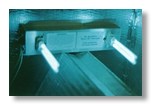|
Comtech Research LLC Newsletter No. 2 - December 14, 2003
We are pleased to bring you issue number two of our newsletter. We welcome suggestions for future
newsletters, as well as questions on this one.
Hydroxyl and Air Purification
By Howard D. Lash, Comtech Research
LLC
|
As scientists look into the mechanisms through which our earth cleanses itself of environmental
pollutants, they continue to learn fascinating things. Much of what they discover about the natural
processes occurring on a global scale can also be beneficially applied to our personal
environment�our homes. In this newsletter, we will take a closer look at one current field of
research, the crucial role that hydroxyl molecules play in the purification of the air in earth's
atmosphere. We will also see how the practical application of this research can improve the quality
of the air we breathe right now inside our own homes. �
Why is hydroxyl vital to the health of earth's atmosphere?
There is currently some disagreement among scientists regarding possible long-term changes in the
hydroxyl level of earth's atmosphere. However, there is no disagreement whatsoever regarding the
crucial role that hydroxyl plays in keeping earth's atmosphere healthy. Says Ronald Prinn, of the
Massachusetts Institute of Technology: "This one molecule is very, very important. It is the
critical cleaning chemical for the atmosphere."
Ken Minschwaner of New Mexico Tech concurs. "OH [hydroxyl] reacts with just about everything," he
says, and thus hydroxyl is "important for cleansing the atmosphere of pollutants." And M. A. K.
Khalil, Department of Physics, Portland State University, Portland, Oregon, describes hydroxyl
molecules as "the chemical scavengers of the atmosphere." So hydroxyl molecules appear to play the
key role in cleansing earth's atmosphere of harmful pollutants and organic compounds.
But how does the mechanism of atmospheric cleaning work in practical terms? According to the
Environmental Health Center, "the ultraviolet that reaches the troposphere [the region of the
atmosphere nearest earth's surface] plays a big role in creating hydroxyl." In turn, hydroxyl then
"tends to react quickly with other molecules in the atmosphere. Hydroxyl
ions and ultraviolet radiation
seem to be responsible for much of the eventual destruction of methane, some halocarbons, and a
number of other atmospheric pollutants."
�
So just what is hydroxyl?
According to the Atmospheric Chemistry Glossary, 2003 Version, hydroxyl (OH) consists of
"one hydrogen atom and one oxygen atom which does not normally exist in a stable form." It explains
that the primary source of hydroxyl in the atmosphere is the "1) photolysis of hydrogen peroxide,
heat, and light and 2) the attack on water of an excited oxygen radical."
Dr. Richard Foust, Professor of Chemistry and Environmental Science, Northern Arizona University,
explains further how hydroxyl molecules are produced. "The primary process is one where an O-H bond
of the water molecule is broken to form a hydrogen atom (H- ) and a hydroxyl radical (HO- ). The
hydrogen atom can then react with another water molecule to form hydrogen and a second hydroxyl
radical, or with an oxygen molecule (O2) to form a second hydroxyl radical and an oxygen
atom. The new oxygen atom can then react with another water molecule to form two new hydroxyl
radicals."
�
|
 |
Can hydroxyl be put to work for us in the home? Is it possible for us to make beneficial use of hydroxyl molecules, cleansing the air inside
our own homes in the same way they work to cleanse the earth's atmosphere? The answer, fortunately
for us, is Yes.
The key is to make use of certain key wavelengths of strong ultraviolet (UV) light, which, in the
presence of water molecules occurring as moisture in the air, produces hydroxyl molecules. This
process mimics the natural production of hydroxyl in the atmosphere through ultraviolet radiation
emitted by the sun. This also results in the breakdown of organic material in the air by the
hydroxyl. The organic particles in room air are decomposed into harmless carbon dioxide and water
through chemical action.
�
Ultraviolet light and hydroxyl generation
4.56 Ultraviolet (UV) Oxidation, a publication of the [U.S.] Federal Remediation Technologies
Roundtable, explains how hydroxyl oxidizes and breaks down even dangerous substances and renders
them harmless. "A wide variety of organic and explosive contaminants are susceptible to destruction
by UV/oxidation, including petroleum hydrocarbons; chlorinated hydrocarbons used as industrial
solvents and cleaners; and ordnance compounds such as TNT, RDX, and HMX. In many cases, chlorinated
hydrocarbons that are resistant to biodegradation may be effectively treated by UV/oxidation.
Typically, easily oxidized organic compounds, such as those with double bonds (e.g., TCE, PCE, and
vinyl chloride), as well as simple aromatic compounds (e.g., toluene, benzene, xylene, and phenol),
are rapidly destroyed in UV/oxidation processes."
Additionally, Hydroxyl ions are extremely short-lived molecules. They usually exist for no longer
than a second or so before becoming involved in an air-cleansing chemical reaction. That is
precisely the reason why it has been so difficult to accurately measure hydroxyl levels in the
earth's atmosphere. But it also means that there need be no concern about hydroxyl molecules
accumulating inside the home. Many ozone-generating air purifiers, on the other hand, have the
ability to quickly raise the ozone concentration in a room to potentially unhealthy levels if not
carefully monitored.
�
Conclusion
Hydroxyl has well been called "Mother Nature's Broom." Hydroxyl molecules play a crucial role in
helping to keep the earth's atmosphere clear of chemical pollutants as well as helping to break down
potentially harmful airborne organic compounds. And through the use of hydroxyl-generating air
purifying equipment in the home, we can enjoy cleaner, fresher air in our indoor environment as
well.
�
The Air Probe Sanitizer� ultraviolet-C central air purifier
also produces negative hydroxyl ions, as the above article describes. Please click here for information on this
product.

|
Copyright � 2003
Comtech Research LLC. All Rights Reserved.
No portion(s) may be used by anyone without the express written consent of Comtech
Research LLC
� |

